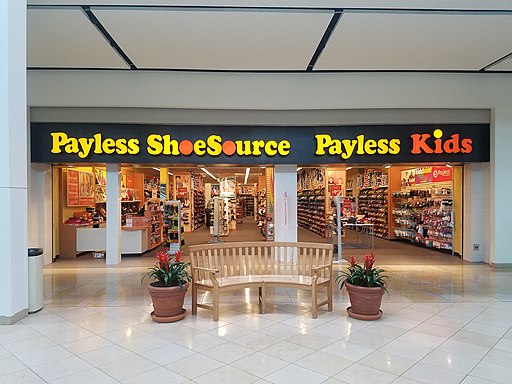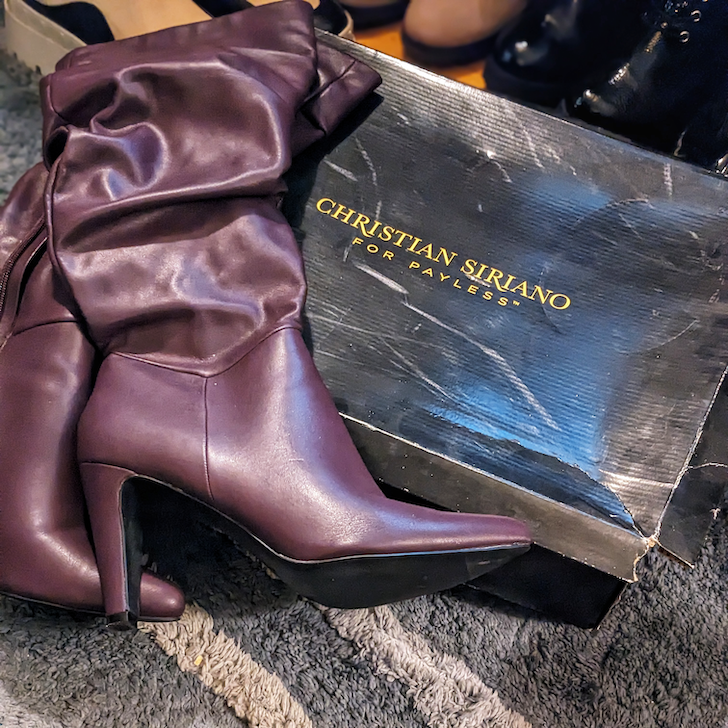Payless Shoe Source; the shoe of Main Street, the shoe of the working class, the shoe of suburban children whose parents knew how to make the best use of a dollar. One of the many casualties of the retail apocalypse, it's a shadow of the corporation it once was...the North American stores declared bankruptcy in 2019, and the remainder of the organization today operates primarily outside the United States.
While the backstory of the organization would be a great topic to cover by itself, the focus in this article will take a less substantive approach. We'll cover the end years with a sample of the shoes made while also highlighting perhaps the most underrated social experiment of 21st century fashion

A Payless storefront in Plymouth Meeting, PA
(Image Source: Wikimedia Commons, licensed under Creative Commons Attribution-Share Alike 3.0 Unported license)
The 'Sole' of Payless
However it's spun, Payless is a cornerstone example of value-end footwear. At their retail peak...and probably throughout their time in the brick-and-mortar space, a consumer was never going to find an inflation-adjusted $80+ price tag on any of their product line. While one would not get anything of durable, time-tested manufacturing methods or high-end materials used for construction. Payless was about putting shoes on the feet of the masses. Needed an athletic shoe that was going to get you through a few pick-up basketball games? Payless could do that. Looking for a office shoe that coordinated well-enough with your business attire without breaking the bank? Payless had you covered. Had to buy kids shoes that would probably be too small in under a year anyway? Yup, Payless was the spot.
Upscale Design for the Masses
In the late 2000's and throughout a big chunk of the 2010's, Payless partnered with designer Christian Siriano, of 'Project Runway' fame to design footwear collections with an upscale edge. Many fashion publications gave media coverage to these collections over the years and overall feedback was positive, emphasizing premium design at affordable prices. Taking a sample of the collection, our archive contains the 'Maerys' boots in violet from the 2017 collection (estimated). Featuring a unique color with ruched detailing in the shaft, a semi-pointed toe, and broad stiletto heel, the design definitely stepped outside of the traditional Payless mold. Materials used are entirely synthetic and construction methods are consistent with mass-production practices. That said, we wouldn't say that mass-production is synonymous with low quality, as the shoes have held up with occasional wear over the past 5 or so years. Overall, despite the business challenges of the times, the collaboration represented an idea that premium design could be carried into value-driven fashion, before the fast fashion machine really picked up momentum.

Christian Siriano ‘Maerys’ for Payless boots in purple synthetic – from fall/winter 2017 (estimated) collection
(Image credit: sartorialsleaze)
The Most Underrated Experiment in 2010's Fashion
In the fall of 2018, Payless went hard on a marketing scheme that challenged the the idea of what a premium & luxury brand really is. To pull off such a stunt, Payless partnered with an advertising firm, DCX Growth Accelerator, which then found a vacant space at a shopping center in Santa Monica, CA occupied by luxury brands such as Louis Vuitton and Tiffany & Co, wherein the stage for this elaborate event was set. Interior designers staged elaborate statues and mannequins to accompany the shoes & boots perched on glass shelves. A social media account was established (which is still viewable at time of writing), and the team scouted out SoCal fashionistas and influencers on the streets to visit the shop. From there, the results speak for themselves:
With such an experiment the reaction, though largely positive, had a pretty good representation of different opinions. Of the more critical viewpoints, Vox headlined their criticism as a 'rude marketing stunt' (because, you know, they're Vox 🙄), and others aligned it as circumstantial to out-of-touch decision making as the company declared bankruptcy prior to the campaign.
Looking back at the whole thing, it's hard not to question a given consumer's perception of quality vs. value. As the value brand they are, the construction is dramatically different from methods that higher-end brands use to construct their product. Even among premium manufacturers that don't use natural leathers and animal-based materials, a brief inspection of a 'Palessi' would scream mass-production.
Could another mass-production brand recreate the stunt in current day? We would say it's entirely possible; especially with methods that higher end brands are using to cut costs and increase margins. Though the topic is a discussion for a different day, let's simply take a moment to appreciate the last hurrah of the people's shoes.